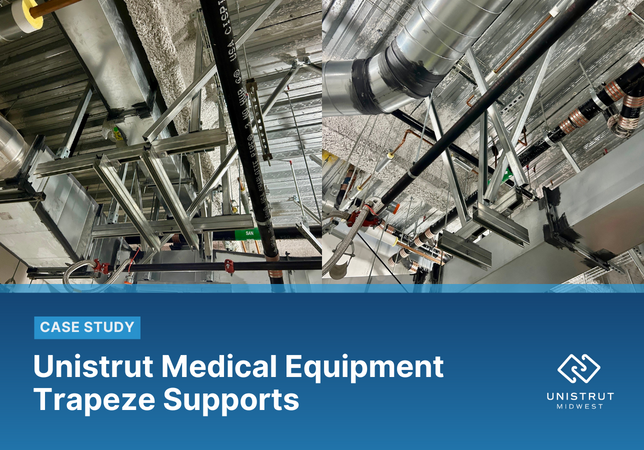Case Study: Unistrut Medical Equipment Trapeze Supports
August 5, 2025
Unistrut Midwest turned a late-stage request into an opportunity to deliver on customer service.
- Our team leveraged the BIM model to adapt to existing MEP interferences before even arriving on site
- The solution was built from in-stock materials so that work could begin next day
- Despite being a last-minute project, the solution was completed on budget and ahead of schedule

Overview
While underway at a medical facility installation project, our team was approached with a new scope of work. It is not uncommon for owners to get a new vision for a space after seeing a build come to life, especially in a medical setting. When this project owner wanted to change multiple existing rooms to be able to perform procedures requiring specific equipment, our team was brought on to design and install the support structures for that equipment.
Because this was a later stage of facility construction, the other trades had already completed their building coordination and installations before the Unistrut Midwest team was consulted for the change. Our team was faced with designing supports for this medical equipment around existing equipment, HVAC, electrical, and additional ductwork.

Approach
Because our team was already involved in the overall project, we had access to the BIM model and were able to view the installed ductwork and determine how many interferences would impact our design. We were able to use that information to identify where we could fit our Unistrut supports and access the building structure for installation, calculate the necessary spans for the supports, and create a design that coordinated with the existing MEP interferences. This information allowed us to create a solution that worked on paper before our installation team arrived on site.

Solution
To accommodate the medical equipment in these rooms, our team designed 42 Unistrut trapeze supports. Some of them had to be made substantially wider than would be typical to bridge around existing ductwork, but thanks to our team's preplanning, no surprises arose once our team was on site.
Although the support designs were unique due to the interferences, all of the trapeze structures were built out of materials that Unistrut Midwest had in stock in our warehouse, allowing our team to rush the materials onto the work site and begin work within one day of receiving approval on the designs.
Our foreman has 15 years of experience in medical support installations, including many projects with both this particular hospital and this project’s general contractor. He is well-versed in adapting materials to atypical constraints, such as those encountered on this project. Through his due diligence in addressing issues before arriving on site, our installation team was able to complete the support system on budget and ahead of schedule.

